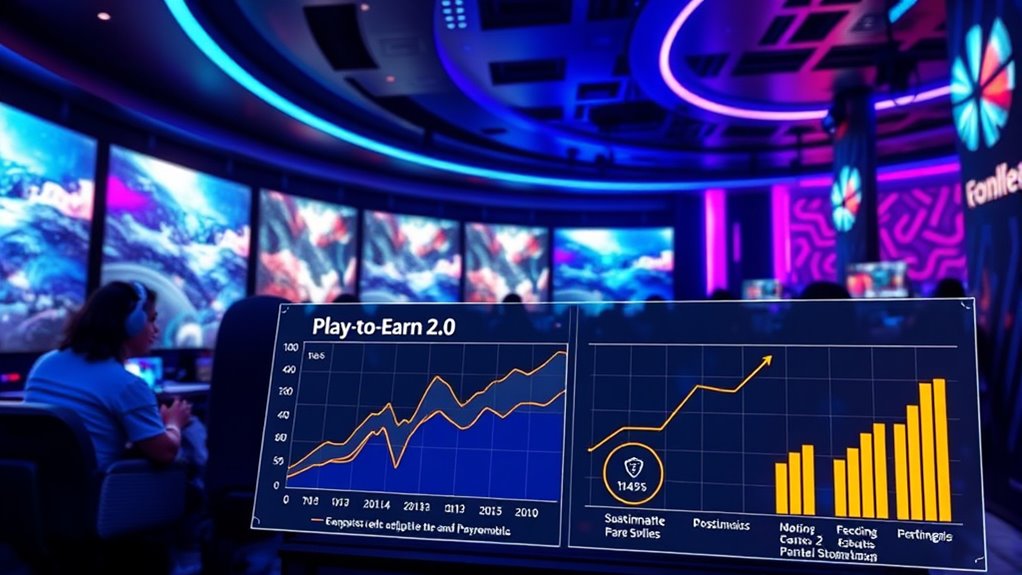Play-to-Earn 2.0 aims to create sustainable gaming ecosystems by integrating transparent tokenomics and active community governance. Instead of risking Ponzinomics, it focuses on fair rewards, balanced incentives, and player involvement in decision-making. Proper tokenomics prevents inflation and manipulation while fostering trust. If you continue exploring, you’ll discover how these innovative models are reshaping the gaming landscape and building long-term, resilient economies for players like you.
Key Takeaways
- Well-designed tokenomics and transparent governance are essential for ensuring Play-to-Earn 2.0 ecosystems are sustainable.
- Proper balancing of token supply, demand, and incentives prevents inflation and Ponzinomics.
- Community involvement and governance help maintain ecosystem stability and align player interests with long-term health.
- Transparency in token distribution and decision-making builds trust and deters manipulative schemes.
- Sustainability depends on integrating economic incentives with responsible resource management and proactive ecosystem oversight.

Play-to-Earn 2.0 is transforming the gaming landscape by offering players more than just entertainment—they can now earn real value through their in-game activities. This shift isn’t just about earning tokens; it’s about creating sustainable ecosystems where players have a stake in the game’s future. Central to this evolution is thoughtful tokenomics design, which determines how tokens are distributed, used, and valued within the game. When done right, it balances supply and demand, incentivizes active participation, and prevents inflationary spirals that could devalue the in-game economy. You’ll find that developers are increasingly focusing on transparent tokenomics, clearly outlining how tokens enter circulation, how they’re rewarded, and what mechanisms prevent abuse or manipulation. This transparency builds trust, encouraging players like you to engage more deeply, knowing the system is fair and sustainable. Additionally, implementing proper contrast ratio considerations in the game’s design can enhance visual clarity and immersion, making gameplay more engaging and accessible for all users. Community governance plays an essential role in Play-to-Earn 2.0, empowering players to have a say in key decisions about the game’s development, economy, and future updates. Instead of a top-down approach where developers dictate every change, community governance invites players to participate in voting processes, propose improvements, and influence the direction of the game. This creates a more democratic environment where your voice matters, fostering a sense of ownership and long-term commitment. When players are involved in governance, they’re more likely to support initiatives that ensure the ecosystem remains balanced and sustainable. This inclusivity also helps identify potential issues early, as community members can flag concerns or suggest adjustments before problems escalate. In practice, this means tokenomics isn’t just a behind-the-scenes concept; it ties directly into governance mechanisms like staking, voting rights, and reward distribution. You might stake your tokens to participate in governance proposals, earning the right to influence decisions that affect the game economy. This interconnected system encourages responsible management of resources and aligns incentives across the community. When players feel they’re part of a transparent, participatory system, they’re more likely to invest time and resources, knowing their contributions shape the game’s future. Ultimately, by integrating robust tokenomics design with active community governance, Play-to-Earn 2.0 aims for a sustainable model—one that rewards players fairly while maintaining the health and longevity of the ecosystem.
Frequently Asked Questions
How Do Play-To-Earn 2.0 Games Ensure Long-Term Player Engagement?
You can keep players engaged long-term by designing virtual economies that reward ongoing participation and skill development. Play-to-Earn 2.0 games focus on dynamic rewards, meaningful progression, and community engagement, which boost player retention. By creating systems that evolve and offer new challenges, you encourage players to stay invested, ensuring the game remains compelling over time and prevents the decline seen in traditional models.
What Are the Key Differences Between Play-To-Earn 1.0 and 2.0 Models?
You’ll notice that Play-to-Earn 2.0 differs from 1.0 mainly through NFT integration and revenue sharing, making gameplay more sustainable. Unlike the earlier models focused on quick profits, 2.0 emphasizes long-term engagement by allowing players to earn and own unique assets. This shift promotes a balanced economy, where players participate actively and share revenue, creating a more resilient and player-focused ecosystem.
Are Play-To-Earn 2.0 Games Accessible to Non-Crypto Users?
You might wonder if Play-to-Earn 2.0 games are accessible to non-crypto users. Many titles now feature NFT integration to enhance gameplay and provide real value, but user onboarding remains a challenge. Developers are working to simplify the experience, making crypto elements less intimidating. As a result, more players can enjoy these games without deep crypto knowledge, broadening accessibility beyond traditional crypto communities.
How Do Developers Prevent Economic Collapse in These Gaming Ecosystems?
You prevent economic collapse by managing token inflation carefully and aligning developer incentives with long-term sustainability. Developers should implement mechanisms like token burns or capped supplies to control inflation, ensuring the economy remains stable. They also need to design incentives that reward players and creators without causing excessive token issuance. This balance helps maintain ecosystem health, encouraging continued engagement while avoiding the pitfalls of Ponzinomics.
What Role Do Community Governance and Player Feedback Play in Sustainability?
Community governance and player feedback are crucial for sustainability. You play a key role by engaging in voting mechanisms that shape tokenomics transparency, ensuring the ecosystem remains balanced and trustworthy. Your input helps developers adjust economic models, prevent inflation, and maintain long-term viability. Active participation fosters trust, aligns interests, and keeps the community resilient, making the game ecosystem more sustainable and less prone to collapse or exploitative schemes.
Conclusion
As you explore Play-to-Earn 2.0, it’s clear that sustainable models are possible but not guaranteed. You need to stay cautious and critically evaluate how these games generate value and rewards. While some projects aim for long-term growth, others risk falling back into ponzinomics. Ultimately, your success depends on choosing games with transparent economics and real utility, so you can enjoy the benefits without falling prey to risky schemes.








